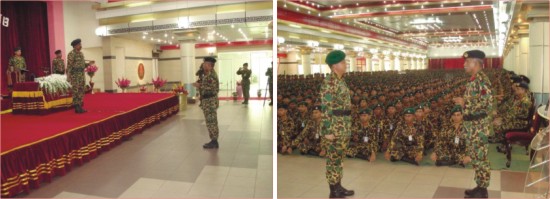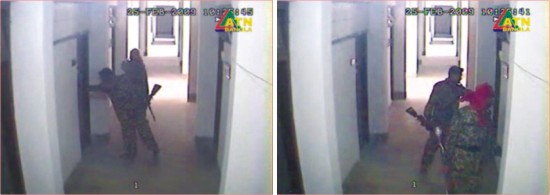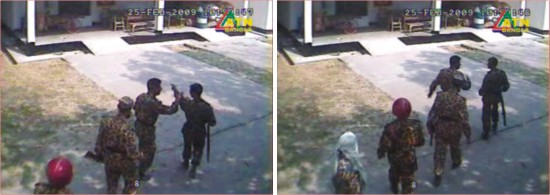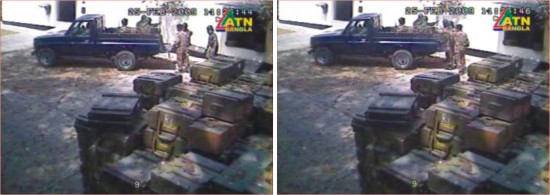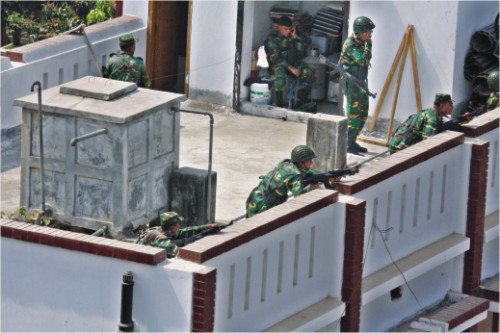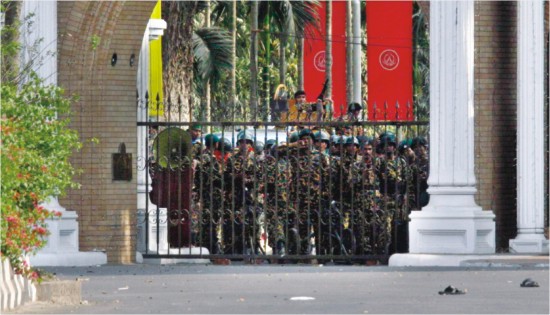
Inside
|
Chronicle of Tragedy and the Pendulum of Sentiment SYEED AHAMED puts together the definitive Pilkhana time-line based on eye-witness accounts Comment is free, but facts are sacred
It was appalling to witness the fast swinging of the "sentiment pendulum" during the course of the BDR mutiny. When the first news of the mutiny broke, the sentiment pendulum decisively swung towards the mutineers, partly owing to their socio-economic background but mainly due to the stories of deprivation they managed to deliver to the public. We saw people gathering around the BDR gates shouting solidarity, media focusing on the deprivation of soldiers, and some pundits even going as far as portraying it a "class revolt." After the mass graveyards were discovered, however, the sentiment pendulum swung hard in the opposite direction. People were shocked with the brutality of the massacre. Media switched from "mutiny" to "carnage" in referring to the incident. Around the world people took part in spontaneous candle light vigils. The initial pro-BDR public reaction dearly hurt the feelings of friends and family members of the army officers -- this sentiment was evident in the blog posts of cadets and army officers. The subsequent anti-BDR momentum should have created an equal anxiety for the family members of the innocent BDR soldiers who are still waiting for the fate of their sons and brothers. Disturbing, but not surprising, was the political blame game that took place subsequent to the massacre. While the raw emotional outbursts of the victims were received with sympathy, the widespread conspiracy theories added spice to everyday conversation. But most importantly, it was this swinging of sentiments that should remind us the consequences of extreme emotions, awkwardness of ignorant preconceptions, and fallacy of prejudiced belief. The investigation is ongoing, and it is best to leave it to the proper authorities to find the answers to all the unanswered questions. Instead, this article uses the actual eyewitness accounts of the surviving army officers to form a detailed timeline of events. Using this timeline, we can explore a range of questions without emotional prejudice. Specifically, we can address the viability of a military solution to avoid the atrocities.
The Chronicle of Eyewitnesses The Mutiny Breaks Out According to TFI, some jawans gathered at the field of 44 Rifles Battalion during the same time and proceeded to quarter-guard in two groups to loot the armoury. There they incarcerated the quarter guard in-charge Maj Riaz, got heavily armed and equipped a grey pick-up with ammunition. Back in the hall, Maj Monirul Alam was listening to the DG who was giving a financial account of the daal-bhaat program. Addressing the suspicion surrounding the program, he assured the audience that the profit would go to a common fund. Lt Col Kamruzzaman could hear the commotion at the very back of the audience where some jawans were chanting slogans and making catcalls. Within minutes of DG's speech, Kamruzzaman saw two jawans running towards the DG. It appears from the images, taken during that moment and available online, that they probably came either from behind the curtain or from the side of the stage. According to Kamruzzaman, the jawan nearest to the DG appeared nervous. One of the pictures shows four officers, probably including the DG and Brig Gen Bari, capturing the jawan while other pictures showing some ten to twelve officers rushing in to help. The last picture shows the jawan lying on the floor unconscious. It is not clear from the picture whether both the jawans were held down, but according to most eyewitnesses, the other jawan fled away through the window amid the chaos.
Sounds of gunshots were coming from outside the darbar hall and within minutes, Kamruzzaman realised that the thousands of jawans who were in the darbar just left. Maj Jayedee heard the DG asking everyone to leave, but this could not be validated by other narratives. According to one anonymous eyewitness, some officers including him left the darbar hall during that time by taking off their badges.1 Jayedee heard another group of jawans coming. One officer began firing with the weapon he reportedly took from the first jawan, but others stopped him arguing that one weapon would not make any difference. Soon, the firing outside the hall intensified. Kamruzzaman heard the DG commanding the sector commander Col Mujib and other battalion commanders to rush to the units and call for special darbar to find out the causes of the rebellion. Kamruzzaman saw the DG making several phone calls seeking a rescue operation. Col Gulzar also contacted RAB through his personal connection (he served at RAB before joining the BDR). Jayedee saw some soldiers coming inside the darbar. When he approached them to talk, one jawan tried to assault him. But soon other jawans rescued him from there and took him to a safe shelter. Meanwhile Lt Col Shams saw Subeders Saiful, Siraj and Ismail from his Battalion-44 among the soldiers. They informed Shams that the situation had gone way out of control and he should escape as soon as possible. They helped him escape the scene and took him to their quarters at Al Beruni Bhaban. On his way, Shams saw a grey-coloured pick-up approaching the darbar hall from the fifth gate of BDR HQ, apparently loaded with boxes of ammunition (CCTV footage released afterwards shows a pickup being used to carry ammunition several times during the day). Shams thought he had never seen such a pick-up used either by the BDR or the army before. Maj Monirul Alam also saw some 30 to 40 soldiers coming to the Darbar Hall with that grey pick-up. Soon the armed soldiers cordoned the darbar hall. Kamruzzaman saw them firing together through the windows into the darbar hall. Four soldiers went into the hall and began firing. Kamruzzaman, along with the DG and a few other officers, went behind the stage into the greenroom for shelter. Maj Monir ran into the nearby washroom where he saw one of his colleagues and a "religious teacher" hiding. One heliIn the meantime, outside the BDR HQ, one tea hawker was shot dead while another shopkeeper was wounded near the Jhigatola area. One BDR soldier and four civilians were admitted to the DMC Hospital during the same time. Apparently, some jawans were shot as well during the first hour of shooting rampage. Many jawans jumped over the boundary walls of BDR HQ and fled for safety during this first hour of the mutiny. The Brutal Carnage At around 9:45am, Kamruzzaman realised that the mutineers had come to their hideout. Through a megaphone, they asked the officers to come out from the hideout in single file. There were only a dozen or so officers in the greenroom at that time, including the DG. A couple of masked jawans came inside, blank fired, and escorted the officers in line through the washroom behind the hall. According to TFI, one masked soldier, standing beside the pick-up, first shot at the DG and then others joined in. Kamruzzaman saw the DG fall to the ground. He crawled down to the nearest bathroom for shelter, escaping major injury. But he could still hear the shooting from inside the bathroom. Minutes later when the solders brought Kamruzzaman out from his hideout, he found that the soldiers had already killed all the officers there. At this point, they escorted him to a safe shelter. On the way, he couldn't watch properly what was happening in the surroundings as the soldiers were continuously threatening him to keep walking forward. Maj Monirul Alam could hear the continuous gunshots from his hideout inside the washroom. After 10-15 minutes, two soldiers came to the washroom to search for officers. He heard one soldier threatening the "religious teacher" to come out from the washroom and asking him if any other officers were hiding inside. According to Maj Alam, the religious teacher avoided the question and left the room silently. Unfortunately, one of the soldiers saw Maj Maksud's feet and began firing. Maj Monir heard the soldiers emptying a whole SMG magazine into Maj Maksud's chest. Alam acted dead by putting the blood of his colleague on his body. When the soldiers left the room thinking that they both died, he ran to a nearby drain to hide himself. From that place he could hear the soldiers calling the officers to come out of their hideouts and as soon as they came out, they were killed cruelly. Lt Col Kamruzzaman estimates that the most of the killings were done during the "initial agitation." In one interview, he mentioned that the BDR DG was killed within "10 minutes after the shooting began." Lt Col Shams could hear the sound of gunshots from his hideout at the Al Beruni Bhaban. He estimates: "It was between 10:30am to 11:00 am that most of the officers were killed."
The First Round of Negotiations Two more civilians, Erfan Ali and Rickshawala Mukul, were shot at Dhanmondi Lake. The prime minister sent state minister for LGRD and co-operatives Jahangir Kabir Nanak and Jatiya Sangsad Whip Mirza Azam to BDR HQ for negotiation at around 12:45pm. Nanak requested the BDR rebels by a loudhailer to halt firing and gave them his mobile number to call back for negotiation. It was evident from the TV footage that there was no identifiable leadership among the revolting soldiers, which delayed the negotiation process. By 2:30pm, Nanok and Azom entered the BDR HQ with a white flag with a hope to negotiate. They met some rebel members there and took a 14-member BDR envoy team to the prime minister's residence. The chiefs of defence forces and RAB were present at Jamuna till the end of negotiation, but they were not present at this meeting. In the meantime, dead bodies of two army officers were found at Nababganj Sluice Gate, both came through the drain according to RAB-10 DD Morshed Ali. The TV channel ATN Bangla was broadcasting the interviews of mutineers who were expressing their grievances. When watched carefully, most of the soldiers looked very young and unorganised, and obviously without a clear leadership at that time. When asked about the causalities and whereabouts of BDR DG, one soldier from the left side of the screen shouted: "All are dead," while others denied immediately. Apparently they were trying to hide the carnage. They even demanded that the prime minister walks in through the BDR third gate without security and vehicle for negotiation!
Kamruzzaman also noted that the soldiers were not listening to one another, suggesting the absence of a functioning leadership. Most of the surviving army officers later noted that there were many good and hesitant soldiers among the group who saved their lives and protected their family members. At around 6:00pm, Nanok and BDR deputy assistant director Towhid briefed the press about the success of the talk. Still unaware about the massacre, the prime minister offered "amnesty" to general soldiers on promise that the soldiers will accept a ceasefire, surrender weapons, and free the hostages. Though the amnesty was announced verbally without any formal or legal support, a clarification on behalf of the prime minister was soon circulated, excluding the active participants of the mutiny from this amnesty. The Second Round of Negotiations At around 9:45pm, a team of four BDR members met the political envoys. Soon eight more joined. The meeting ended at 12:10am (Thursday morning) and Taposh informed the press that the rebel soldiers had agreed to lay down their arms within two hours. Sahara Khatun, apparently unsecured, entered the BDR compound with Quamrul Islam and Fazle Nur Taposh at around 12:25am. Police ambulance was seen entering the compound to rescue the hostages. By 2:00am, some soldiers began surrendering. Lt Col Kamruzzaman would later know that his wife and children were among these first rescues. In his speech during the prime minister's visit to Army HQ on March 1, he mentioned how difficult and risky it was for the political envoys to handle the rescue and negotiation efforts. He revealed how, after a prolonged negotiation, the BDR men agreed to free ten army officers (him inclusive). But when the political envoys were taking out the officers with them, suddenly a group of soldiers revolted and denied to free any officers until the army was withdrawn fully. Kamruzzaman saw the political leaders risking their lives by rushing out to the BDR gate with the officers. He could hear at least four rounds of gunshot by the agitated BDR soldiers.
The chief of armed forces held another emergency meeting with the PM and left the Jamuna at around 2:00pm. Another group of political envoys went to BDR to give them one last chance to surrender. The political leaders warned the BDR men about the prime minister's intention to take the hardline. People living within 3km of BDR HQ were asked to evacuate the area. With tanks and armoured vehicles taking positions around BDR HQ, the prime minister's speech was televised at around 3pm. In her speech, she appealed to the BDR men to lay down their guns immediately and warned them not to force her to take tough actions. According to Lt Col Shams, the PM's speech worked like magic. A group of soldiers began surrendering weapons following the speech. Two soldiers hung a white flag on the fifth gate of BDR HQ. Many soldiers began to flee the BDR HQ in civil dress. The street lights inside BDR HQ were turned off, which helped the BDR men escape. According to the director of Dhaka Power Distribution Company Ltd (DPDC) Ataul Masud, the street and security lights inside BDR are operated by 22 main switches which were not turned on during the 26th evening. Later, the detained BDR men reported to the TFI cell that they kept the street lights off to help rebel soldiers escape. Sahara Khatun continued the talks with BDR men about the surrender and release of hostages. Soldiers freed the captive women and children along with the remaining army officers. However, paramilitaries around the country were still holding their positions to resist any likely military offensive in retaliation for the BDR event.
Politics or Military Intervention Could a fast counter-offensive to neutralise the mutineers, instead of the political intervention, save these precious lives? Was there enough time to move force for the rescue? If the force were used, could it safeguard the remaining hostages? Was political intervention the only inevitable solution or was it pushed unnecessarily? The country will (or still is) sink into these questions for the next few weeks. We cannot answer all these questions based on our understanding of the chronology of events. But one thing is for sure, there was not enough time to save the officers who were killed during the initial agitation. Different witnesses estimated different time period about the major killings. There are obviously some inconsistencies in the eyewitness accounts. For instance, while the pictures and other sources confirm that the program commenced at 9:00am, Maj Monir in one TV interview (accidentally) cited that the program began at 10:00am. Lt Col Kamruzzaman mentioned that the jawans came to capture them from the greenhouse at around 9:45am, and that the DG (along with others) were killed within 10 minutes of their arrival. But during a meeting with the prime minister at the Army HQ on March 1, the eyewitnesses would mention that the jawans came to kill them only after 10:45am. We believe most of the inconsistencies emanated from the horrific shock and trauma they went through during the past thirty or more hours. But most eyewitness accounts suggest that the brutal carnage happened between 9:45am and 10:30am (or extended till 11:00am). One eyewitness would question during PM's meeting at Army HQ as to why the military could not be moved to their rescue within one hour? However, it wouldn't have made any difference to those departed souls who were killed during the first hour. But could force at least have reduced the sufferings of the hostages? We do not know for sure. But we do know that the killers did not handpick whom to kill and whom not to. The officers who survived the carnage were also shot at. Even the very soldiers who rescued them and provided shelter, many of them kept on threatening them. Seemingly unorganised, the soldiers were not even listening to one another. While one tried to save an officer, others tried to kill him. More importantly, according to the confessions made to TFI, the soldiers ran amok each time they sensed a possible operation -- when the army came near the fourth gate, when the chopper patrolled or when the mobile network went off. They even shot outside the compound, killing some civilians. Since a number of mutineers were cold-blooded killers, any uncalculated action could have endangered the hostages. Having military/paramilitary bases within a densely populated city may have hindered a swift operation as well. We have seen that the authority had to take time to evacuate the nearby residential areas when at the end they prepared to use force.
There is no denying the fact that a swift rescue operation would have been more desirable. As one army officer would argue during the PM's meeting at the Army HQ: "It was rebellion situation and hence needed a military solution." We are sure that the government is already thinking of strengthening the capacities of SWAT and guerrilla operations to avoid any future incident. But apparently for this time, political intervention did not come as an alternative; it simply became the unavoidable second best choice to follow, to which the political envoys responded with great courage. According to the eyewitness accounts, moving around inside the BDR HQ without security was not an easy task for the political envoys and a couple of times they also came under fire. Also, we do not know how the BDR camps around the country would have reacted if force had been used. While we mourn the deaths of the brave officials, we acknowledge the government support towards the family members of the slain officials. While we acknowledge the bravery of the BDR jawans who came to rescue many officials and their family members by risking their lives, we are happy to know that they will be honoured properly once identified. We are relieved to witness the judgment of the army leadership to remain under the political headship during this tough time. It is all the more remarkable given the fact that this same command were in functional power of the country only two months before this BDR carnage. We hope that the actual criminals both insiders and outsiders will be brought to justice and punished accordingly, and that emotional vengeance and extra-judicial toture will be avoided. We want the sentiment pendulum to stop here. Syeed Ahamed is a policy analyst. 1. Prothom Alo archives. |

